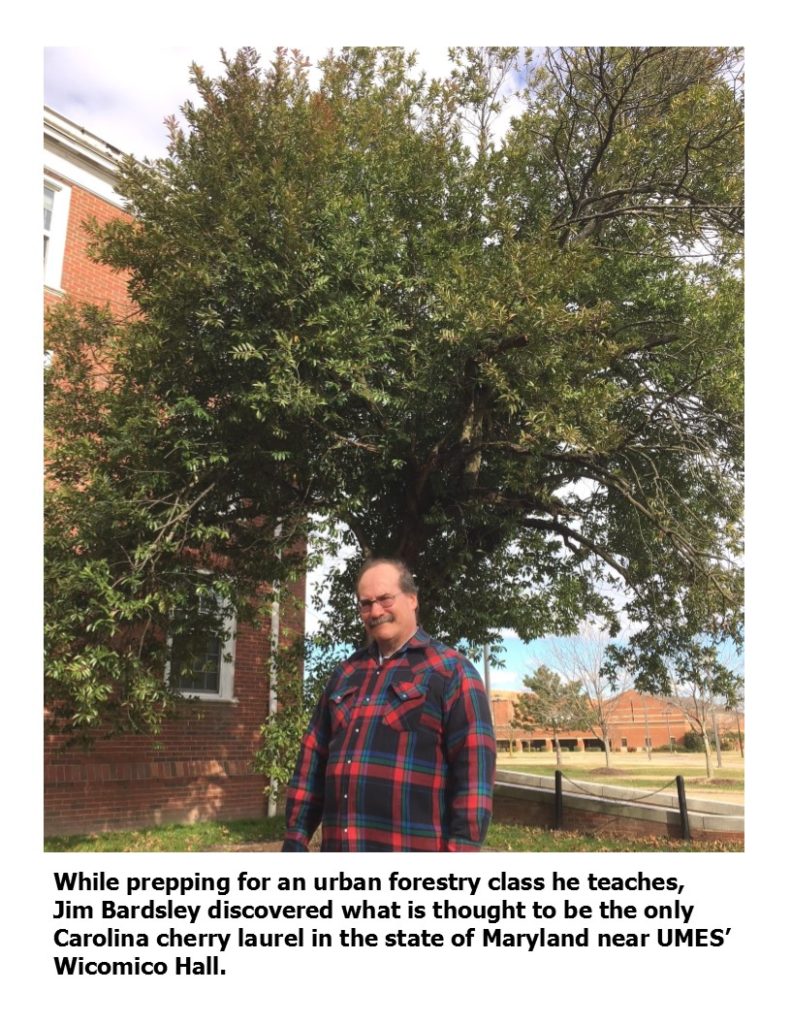
… and some other really big ones, too.
Thursday, January 17, 2019
The lone Carolina cherry laurel (tree) known to exist in the state of Maryland can be found on the campus of the University of Maryland Eastern Shore.
That, by default, makes the evergreen adjacent to Wicomico Hall the state champion of its species, according to the Maryland Big Tree Program, an all-volunteer organization sponsored by the Department of Natural Resources’ Urban and Community Forest Committee and the agency’s Maryland Association of Forest Conservancy District Boards.
The tree made the list after Jim Bardsley discovered it while researching trees and shrubs across campus to incorporate in a class he teaches as an urban forestry specialist in the Department of Agriculture, Food and Resource Sciences.
“I knew it was special,” Bardsley said. “I hadn’t seen anything like it.”
“Then, it was a question of figuring out what it was,” he said. “Usually, when we find something new, it ends up being from another country, but this was from the southern United States.”
Because UMES’ Carolina cherry laurel is considerably farther north than its usual range, Bardsley faced a challenge convincing peers he had found a rare species in Maryland and then proving it.
Leaders of the Maryland Big Tree Program registry at first were “highly skeptical.”
After extensive research, which included documenting its foliage and fruit, the registry accepted Bardsley’s nomination in 2017. It measures 29 feet high with a spread of 29½ feet and a circumference of 53 inches.

Carolina cherry laurels also can be pruned to serve as hedge shrubbery, so a stand-alone tree made the one at UMES stand out.
Bardsley is a Maryland Big Tree Program volunteer who travels the Eastern Shore sizing up large trees, looking to pinpoint “state champion” and occasionally national champion species. The group has identified some 250 state champs, according to its web site.
Only one other “state champion” tree on the registry can be found in Somerset County – a majestic southern magnolia on West Post Office Road about 4 miles east of the UMES campus.
Wicomico Hall was built in the mid-1960s as student housing at a time when landscape architects experimented with stretching the natural range of trees and shrubs to create unique looks for clients.
Bardsley said that likely explains how an evergreen commonly found in the Carolinas and in the more temperate South found its way to Maryland.
The Maryland Big Tree Program also hands out “county champion” designations to large trees, and UMES is home to three such species; a loblolly pine behind Kiah Hall, a water oak and a white ash both adjacent to Trigg Hall.
The pine tree, also measured in 2017, is 95 feet tall and 105 inches in circumference at chest height.
The Maryland Big Tree Program uses a point system utilizing a geometry- inspired formula that takes into account height, circumference and “maximum crown spread.”
The white ash near Trigg Hall is 91 feet tall and 154 inches in circumference, while the water oak is 66 feet tall and 151 inches around.
Three other trees on the UMES campus also are listed among the largest in the county; willow oaks near Carver Science and Tanner halls and a second loblolly pine just west of the campus police station.
“The Big Tree Program inspires people to learn about the importance of trees in the environment,” Bardsley said. “Not only do big tree owners become better stewards and conservationists, but the program is also highly competitive.
Old Man Winter felled the state’s largest wax myrtle tree – also known as a bayberry – when a snow storm during the 2017-18 academic year toppled the tree adjacent to the shuttle bus stop between J.T. Williams and Waters halls.
“It’s always sad when you lose the largest known specimen for any species,” Bardsley said.

